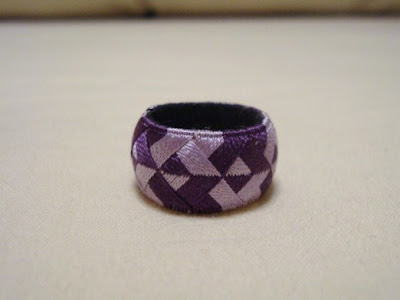


Now, a lucky winner is Surya in Malaysia who shared her shaft feathers design bangle in pink and yellow. As she said in her message left, it's a quad-scales design using only two colours, so you can call it quad-scales but more commonly called as shaft feathers, as in a long bow's. Surya, please send me an e-mail for your shipping address. You can send it from my profile page.

These are my recent ring bases for pin cushion. They are nothing to do with this post but I think it's always nice to have a picture to share, so here it is. I suppose you remember that I have started to sell "your first thimble making kit" at my Etsy shop. So far I made 22 sales and the responses from the people who bought it were favorable and a few people asked me if advanced kit(s) will be available in future. When I first thought of selling thimble kits I planed to have two kits; "first thimble kit" and "beginner's starter kit". The former one is what on the shelf of my shop now, a finished thimble base with two rows of stitches already done. The latter one, a starter kit, should include all the key materials such as core paper, bias binding, silk threads, floss silk padding, and so on with instruction booklet which shows you how to make a base, how to pad it, and how to stitch. You can make at least three thimbles using the material included. That was a plan. Now I have become ambitious and dreaming of a "thimble of the month club". The first month's thimble will be very similar to the "beginner's starter kit" and from the second month and onward, you will receive a design diagram and instruction with maybe two cards of thread every month, perhaps a 6 months subscription. In this way the people who are new to thimble making can gradually familiarize themselves and learn more complex designs, too. In any way it certainly takes a few months before I can produce a new kit for you. In the mean time, I would appreciate your input in this matter.
I will start a new Share Your Thimbles the day after tomorrow. Happy stitching!

 Before you start, you have to know exactly how many stitches you are able to make in one section if you want precise stripes.
Before you start, you have to know exactly how many stitches you are able to make in one section if you want precise stripes.




